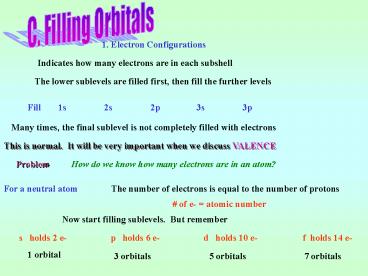C' Filling Orbitals - PowerPoint PPT Presentation
1 / 6
Title:
C' Filling Orbitals
Description:
Many times, the final sublevel is not completely filled with electrons ... Notice how one electron goes into each orbital of a sublevel before they pair up. ... – PowerPoint PPT presentation
Number of Views:58
Avg rating:3.0/5.0
Title: C' Filling Orbitals
1
C. Filling Orbitals
1. Electron Configurations
Indicates how many electrons are in each subshell
The lower sublevels are filled first, then fill
the further levels
Fill
1s
2s
2p
3s
3p
Many times, the final sublevel is not completely
filled with electrons
This is normal. It will be very important when
we discuss VALENCE
How do we know how many electrons are in an atom?
Problem
For a neutral atom
The number of electrons is equal to the number of
protons
of e- atomic number
Now start filling sublevels. But remember
s holds 2 e-
p holds 6 e-
d holds 10 e-
f holds 14 e-
1 orbital
3 orbitals
5 orbitals
7 orbitals
2
If our atom has 8 e- in the ground state, we
would write
2p4
e- left
1s2
2s2
2p
4
8
6
4
Energy level
sublevel
e- in the sublevel
What is the electron configuration for an atom
with 6 electrons?
1s2 2s2 2p2
With 9 electrons?
1s2 2s2 2p5
3
Write out the electron configuration for the
following elements
Element of e- e- configuration
5
Boron
1s2 2s2 2p1
10
Neon
1s2 2s2 2p6
Sodium
11
1s2 2s2 2p6 3s1
Remember!
1. Look up the atomic number, this will tell you
the number of electrons in the atom
2. Fill subshells in order
1s 2s 2p 3s 3p...
3. Count the electrons in the configuration to
make sure you have enough
4
2. Orbital Notation
Shows how the electrons are placed in each orbital
The orbitals are drawn out as boxes and filled in
with arrows
s p d
level
1
2
3
Each orbital (Box) can hold 2 electrons
Remember the Pauli Exclusion Principal - no
orbital can contain 2 electrons of the same spin
5
Watch how the electrons are filled in orbitals
If the atom has _____ electrons
1s 2s 2p
1 2 3 5 6 9
Notice how one electron goes into each orbital of
a sublevel before they pair up.
6
Write the orbital notation for an atom with 15
electrons
1s 2s 2p 3s
3p
3. Configurations of Atoms in the Excited State
Look at this notation
Because of the 6 electrons, this is carbon.
Since the electrons are in the proper place, it
is in the ground state
In the second one, one electron is in the wrong
place. It is too high.
This is carbon in the excited state































